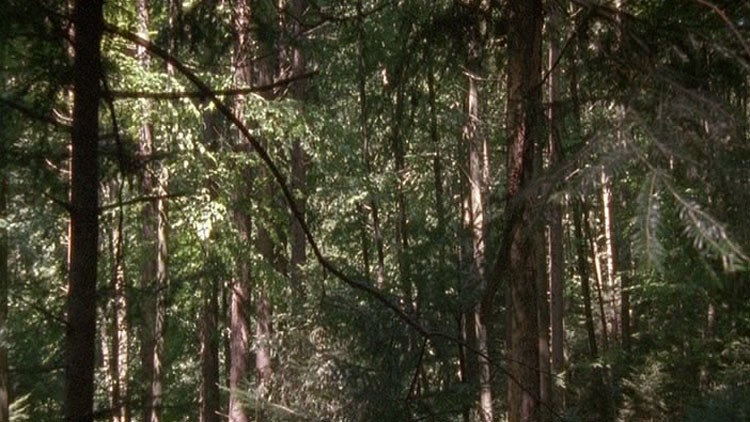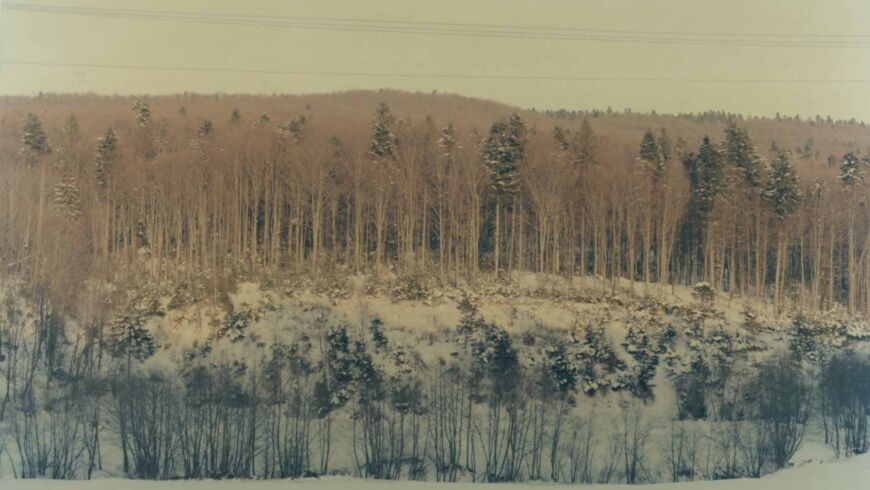Tracks in the Forest
Steven Bode
Steven Bode traces the journey Ori Gersht undertook to research and make The Forest in this catalogue essay from 2005.
Projects
If a tree falls in a forest and there is no-one there to hear it, does it make a sound? A metaphysical haiku haunting the rationalist imperatives of Western philosophy, this little conundrum has exercised some of the finest minds on the planet far more than anyone would have cause to imagine. Like many riddles of its type, the deceptively simple question it poses doesn’t really have a definitive answer, and is contingent on how literal, or pedantic, you might want to be with its basic terms. Rather than go back over each and every nuance in turn, maybe we should focus instead on the line’s poetic dimension, its reminder (for those that want to hear it) of the pivotal tension between nature and knowledge, its emphasis on the primacy of consciousness, and, above all, its playful embrace of paradox. In an age when reason and logic have walked hand in hand with some of the most appalling examples of man’s inhumanity to man, we no longer have such faith in a quest for absolutes.
In the forests of Galicia, in what is now modern-day Ukraine, numberless trees have fallen over untold millennia — most of them crashing to earth long before man ever appeared on the scene. Some of the last remnants of the vast, primordial forest that once stretched over much of Europe, Moskolovka and Sziporovza, like other surviving enclaves, have had their former margins steadily depleted by human encroachment and their sombre calm all-too-regularly disturbed by the violent history of the region, in which Ukrainians, Poles, Russians and Germans (to name only the most recent combatants) have fought their way, in a spiral of increasingly savage retribution, across what has traditionally been border territory. In this contested landscape, forests like Moskolovka and Sziporovza have ambiguous, often competing, resonance. For some, these ancient woodlands are a place of sanctuary, a sacred heartland, even; in which the spirit of the nation is preserved. For others, they are places of darkness and mystery, whose edges define not only the frontiers of human habitation, but also the (fragile) limits of human civilisation.
For writers and artists of the Romantic movement, in particular, not to mention those contemporary figures whose work carries obvious echoes of that romantic sensibility, forests have an equally important, almost archetypal fascination. German Romantic painters like Caspar David Friedrich, to cite the most prominent example, bestowed these ur-forests with a mystical, transcendent presence, wreathing them in early-morning mist or emblazoning them with numinous shafts of light; investing their elemental beauty with enough of a frisson of untamed wildness to evoke a feeling of the sublime. In amongst its shifting mosaic of peoples, we should also remember the Jewish population of this region, many of whom, belying the nomadic or mercantile stereotypes that often attached to them, earned a living there as woodcutters. Alongside its many other characteristics, for them the forest was also a place of work — an abundant and much-loved backyard that supported and sustained them and whose familiar rhythms they knew intimately.

Of the many possible paths into this forest, Ori Gersht has chosen one marked by personal and family history. Brought up in Israel, before relocating to London, Gersht retraced his severed family connections to this part of Galicia over the course of a number of visits made during 2005. Although his own forebears once lived not so far away, across what is now the border with Poland, his destination was the village of Kosov, the birthplace of his father-in-law, Gideon Engler. Outwardly unchanged for generations, counting out its days, as it always has done, in the silent shadow of its watchful mountain, Kosov was, like many other villages in the area, a site of Nazi persecution, which Engler (and his brother and father) survived by hiding out for two and a half years, first in a tiny hole in the ground and then in a nearby attic; eking out a fraught and unimaginably wretched existence, although one that, in its perpetual fear and terror, avoided the fate of Gideon’s mother, who went missing after a subsequent attack, and, like many of their former neighbours, was either led off to the death camps, or taken out to the woods and shot.
Prompted by these stories, and not least by the diary of Baruch Engler (Gideon’s father), whose harrowing account of the time he endured there was given to him to read before he embarked for Ukraine, Gersht’s images record a kind of spiritual journey in which his own emotionally-charged encounter with this unfamiliar yet endlessly evocative landscape is combined with a discreet but equally personal rite of observance; one that cannot help but involve a further confrontation with the horrors of the past. Travelling by train through the empty snow-filled countryside, whose features are further shrouded and blurred by a ubiquitous, ethereal half-light, it is almost as if his subject matter, although uncannily, apparitionally vivid, refrains from presenting itself clearly. Indeed, the ghostly indeterminacy of the majority of his photographs, rather than reading as portentous, seems more redolent, at times, of feelings of uncertainty and doubt. Is this landscape as haunted, and as loaded, as he himself sees it? Have these places retained any traces of what happened over sixty years ago? And, if not, how can they be made to communicate, so that the memory of what once went on there is not to be forgotten? These, and other, parallel, questions, raised at a conceptual, phenomenological level in many of his earlier series, which often use dissolves or extreme exposures to interrogate the documentary status of the photograph and its relationship to history, assume a heightened, and more obviously personal, significance as he makes his approach into Kosov.
The centrepiece of this body of work is a short film called, simply, The Forest. Shot deep in the interior of Moskolovka, it consists of a series of graceful, almost processional pans across bands of individual trees. Following the line of each continuous take, the eye begins to notice a number of the trees mysteriously falling, both at the edge and the centre of the frame. Never stopping to take in each trembling, vertiginous plummet, the tracking camera passes slowly, finally reaching its end-point, changes position, then begins again. The sound of each crash, hugely amplified on the soundtrack, rumbles over the footage, rising and falling like a visceral lament. In between, there are moments of silence, in which the hush of the forest, and a tentative trilling of birdsong, is restored. And then the trees start to fall once more. An elegy for the nameless dead who were lost in wartime atrocities, the piece also enacts the kind of ceaseless vigil that will be needed if these crimes are not to be repeated. The Forest is an extraordinarily powerful work; unstinting and indelibly haunting, it combines a terrible sadness with a quiet yet formidable strength. For every tree that is gone, it seems to say, there are many still standing. And for every tree that falls, there is not just a sound but an echo, reverberating into the present and beyond.

–––
Steven Bode is Director of Film and Video Umbrella.

